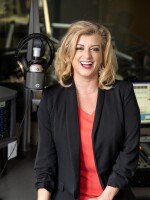A black hole is a region in spacetime where gravity pulls so much that not even light can get out. Because no light can get out, we can’t see black holes.
However, the first ever image of the black hole in our Milky Way – the galaxy that includes our solar system – is making news around the world.
The image of the supermassive black hole - dubbed Sagittarius A* - was taken by the Event Horizon Telescope – a giant telescope made from a global network of radio telescopes that work together as a single instrument.
Joseph Farah, a graduate student based at Las Cumbres Observatory in Goleta, is part of the research team that captured the image.
"They say seeing is believing. It's the first direct evidence of a supermassive black hole in centre of the Milky Way," he told KCLU.
"Seeing it and knowing we are trapped in its gravitational pull is intense," he added.
He saids the size of the black hole is "pretty inconceivable."
"The sun is 6 million times bigger than the earth. The black hole we just took a picture of is another 4 million times bigger than the sun," he said.
The image is the shape of a donut.
"Some people like to compare it to the Eye of Sauron or a glowing fuzzy donut and those are very good descriptions," said Farah.
The black hole is roughly 4.3 million times the mass of our sun and is located about 27,000 light-years away from Earth.
Because of its distance from us, he said it appears the same size in the sky as a donut on the moon, and therefore, trying to get a picture of it required the power of the telescope network.

However, the black hole is not only dark, but also moving, which, Farah explained, made it incredibly difficult to capture the image and required complex new techniques.
He compared it to trying to take a photo of a fast moving toddler with a wide open shutter.
"It would just be a messy blur so this was the challenge," he said.
He developed a technique which captured a movie of the black hole to capture the image.
It’s an important discovery for space fans, but for the scientific community – it’s even more significant.
"It gives us a chance to test general relativity in the strong gravity regime.
"General relativity is probably the most successful theory of physics to date, and it's never been wrong.
"The other most successful theory to date - Quantum Mechanics - gives a different answer for what goes on in the centre of this thing.
"We have effectively taken a picture of the spot in the universe where these two best theories of all time, that have never been wrong - break."
And one more thing about Farah’s exceptional work…he's still only 22-years-old.
"It's been the experience of a lifetime," mused Farah of working on the project.



